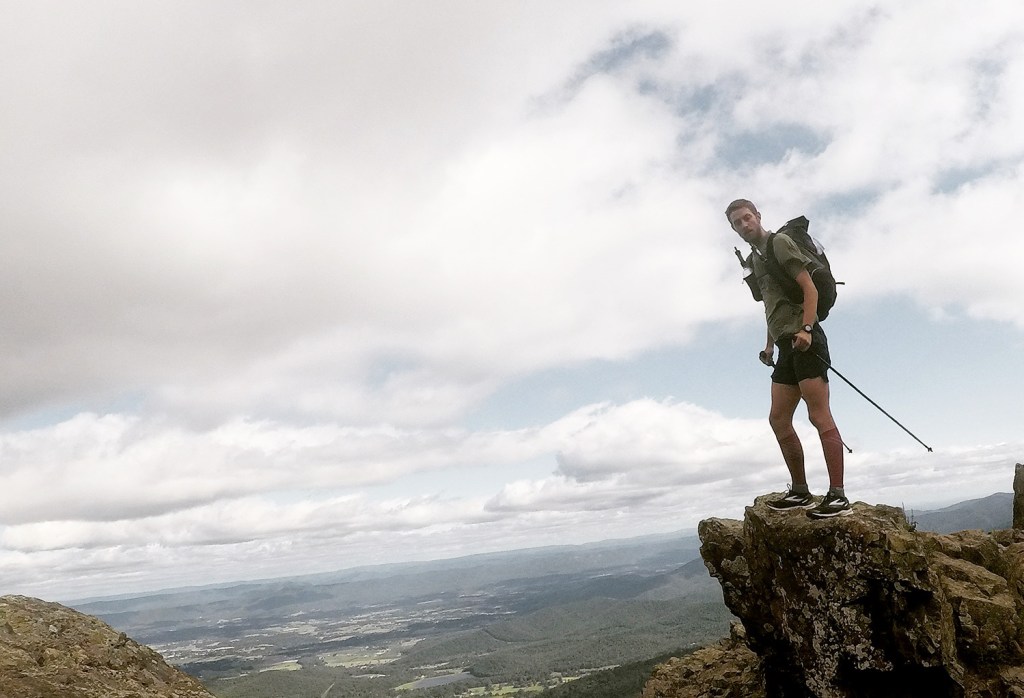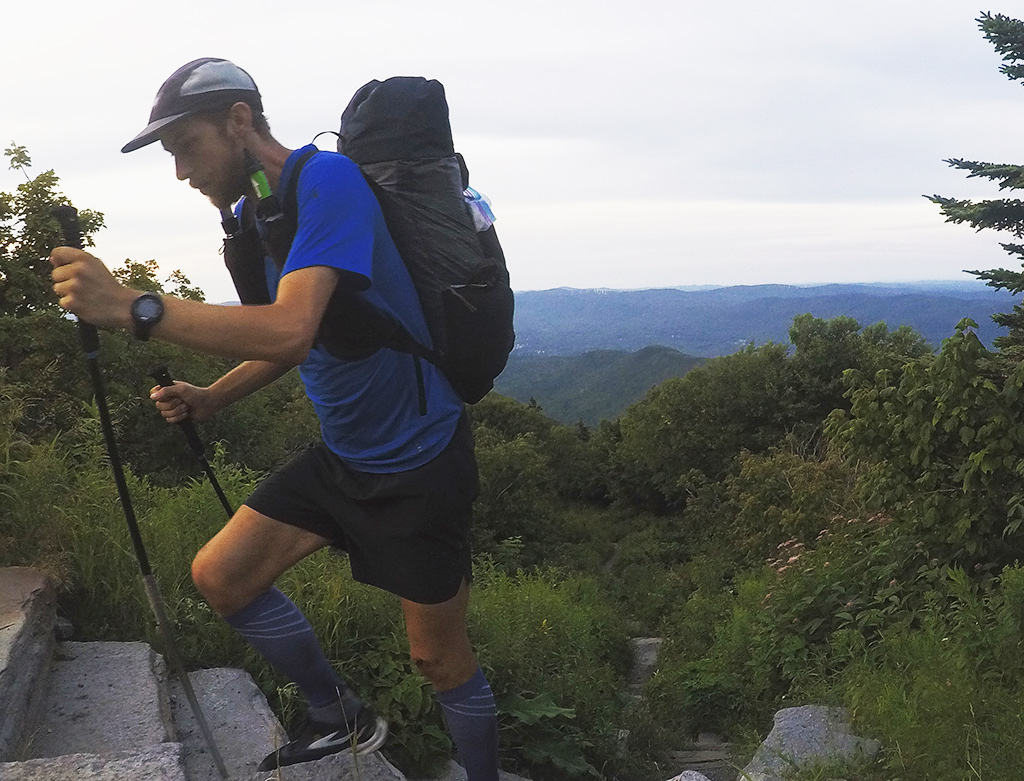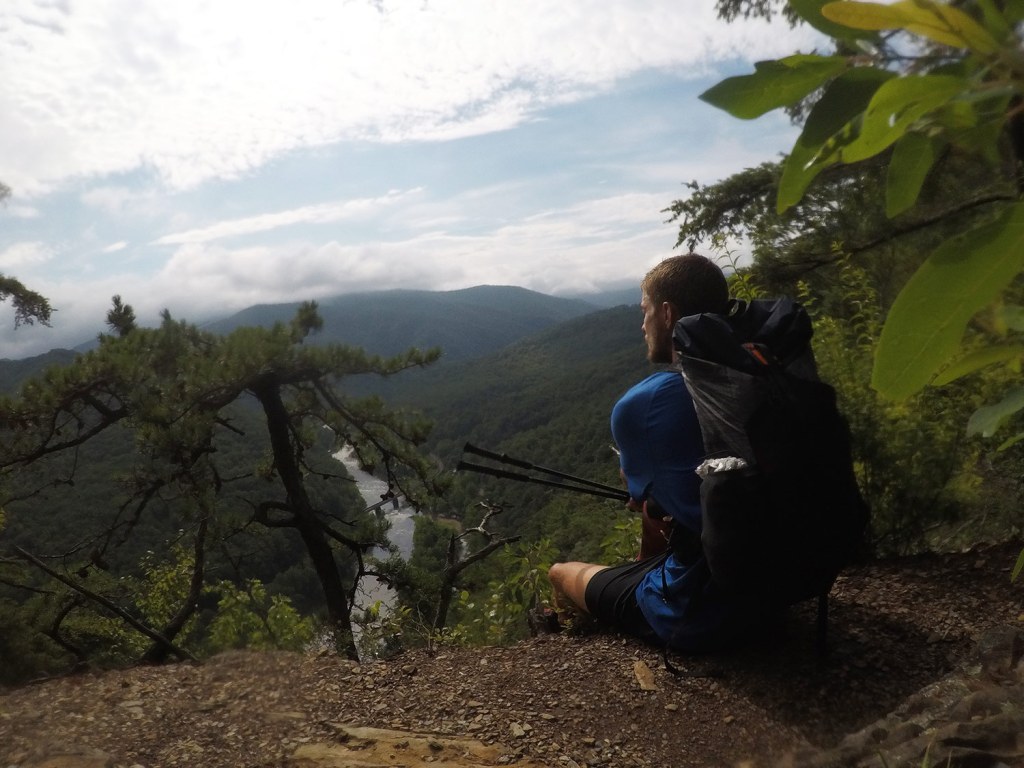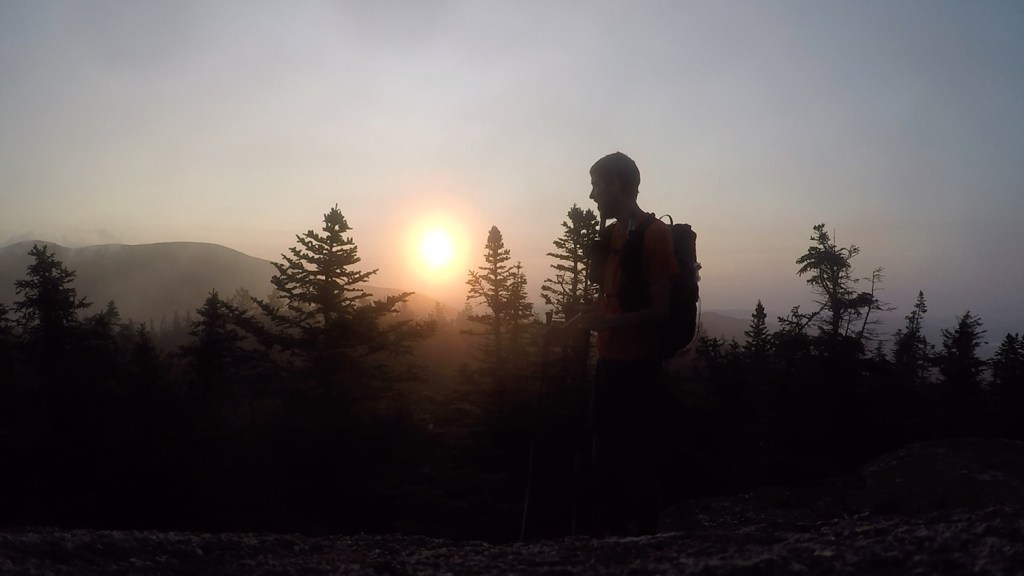He packed light, pushed through pain, followed Fastest Known Time protocol to a T, and even stopped to enjoy the view.
Ultrarunner Joe “Stringbean” McConaughy was well on pace to shatter the fastest known time on the Appalachian Trail until he reached New Hampshire’s White Mountains. A couple falls caused swollen knees, cuts and bruises, and rugged terrain slashed his daily mileages in half. Then, he took the wrong turn. “I lost three hours climbing up a different mountain before dropping off 2,000 feet in elevation, and then had to turn around,” McConaughy says. “I couldn’t help but feel like my abilities weren’t going to be good enough to finish when I was covering that kind of mileage.”
“Certain people come along and redefine what’s possible.”
McConaughy rallied, and a few days later pushed his body to its limit for 37 straight hours over 110 miles to reach Mount Katahdin on August 31. The 2,189-mile journey took him 45 days, 12 hours and 15 minutes, which was enough for the 26-year-old to clutch the Fastest Known Time (FKT) ever recorded on the Appalachian Trail, all without the help of sponsors or a support crew. He resupplied under his own accord, carrying a small amount of gear in a backpack that averaged 25 pounds. Not only did he eclipse Heather “Anish” Anderson’s 2015 self-supported record by nine days, but he bested Karl “Speedgoat” Meltzer’s supported speed record by 10 hours. This is a big deal.
McConaughy’s run highlights a significant point in history for the sport of ultrarunning, says Jennifer Pharr Davis, who in 2011 set the supported FKT on the AT. “I think there are certain people who come along that redefine what’s possible, and I think Joe and his accomplishment have done that with [fastest known times] on the Appalachian Trail,” she says. “And I also think it will be a long time before someone surpasses his record without support.”

Virginia’s Shenandoah Mountains were one of McConaughy’s favorite sections. | Photo: Courtesy Joe “Stringbean” McConaughy
For McConaughy, there’s a duality inherent to speed hiking—it’s both cathartic and hectic. His days were spent consuming nearly 10,000 calories, usually on the go, while averaging around 50 miles a day. But in those moments, as his body propelled him over mountains faster than anyone ever has, his mind slowed to search inward.
“I didn’t have headphones—no music, no podcasts,” says McConaughy, a Seattle native who lives in Boston working as a travel consultant at EF College Break. “I had time just to think, which honestly I value a lot. It was an awesome opportunity to look at everything I’ve done and slow down, think about life away from a busy city and working nine to five. I thought about what I wanted out of life and where I was going.”
Hike your own hike.
This flies in the face of the most common critique of speed hiking on the Appalachian Trail, that racing through the East’s most beautiful terrain doesn’t allow for an introspective experience. The purpose of a thru-hike, some say, is to slow down and connect with nature on an intimate level. McConaughy counters that by reprising a popular mantra among thru-hikers: hike your own hike. Along the way, he says he soaked in many of the must-see views, worked hard for each step and reflected about what he saw, just as a traditional thru-hiker would.
“I experienced every aspect of the trail because I have a lot more riding on each step and am more likely to fall while running,” he says. “For some people, it’s the right experience to do five miles a day. For me, it’s right to cover as much ground as I can.”

Resupplies can be difficult, especially during a self-supported fastest known time attempt. Here, near Garden Center, New York, McConaughy races to make it to a post office before it closes so he can acquire the box he mailed to himself weeks before. | Photo: Courtesy Joe “Stringbean” McConaughy
Although he was solo on the trail, McConaughy is quick to point out the record wasn’t something he achieved on his own. He credits his girlfriend and ultrarunner Katie Kiracofe as a crucial part in motivating him as he trained in the months leading up to the hike. The couple routinely went out for long runs, up to 100 miles a week. He also elicited advice from friends within the running community, eagerly sharing his plans and soaking up feedback before the trek. “It took a village to make the trip happen,” he says.
His mind was in the right place. He was focused and driven.
In 2014, with the help of a small crew, McConaughy set a new supported FKT on the 2,660-mile Pacific Crest Trail (the record has since been broken) where he also earned his trail name Stringbean, a nod to his lean, lanky frame. He ran track since the 4th grade and ran competitively at Boston College. Running has always been therapeutic, he says, even though these momentous ones can take a physical toll on him.
Even as he pushed his body to its limit in those final hours in Maine, McConaughy says it was some of the best running of the entire journey. His mind was in the right place. He was focused and driven. “There were so many moments of joy and grief, sorrow and happiness, elation, wonder and curiosity that I wouldn’t trade that experience,” he says.

There’s time, even on a speed-hike, to enjoy the view. | Photo: Courtesy Joe “Stringbean” McConaughy
McConaughy admits he missed out on the community aspect of the trail, something thru-hikers cherish most from their three- to six-month journey. He was able to connect with a few folks along the way, but many days and nights were spent alone. While seeing friends or family would’ve likely given him a morale booster, he opted to push through alone to stave any questions about receiving help along the way.
On July 19, just as McConaughy was starting his journey, Dan “Knotts” Binde summited Mount Katahdin and claimed to have completed his hike in 53 days, 22 hours and 57 minutes, which was enough to be a new self-supported FKT. His hike was tracked via a Spot GPS tracker. However, most notably due to discrepancies in that data, the claim was disputed. Peter Bakwin, a member of Fastest Known Time, an online forum dedicated to speed hiking, analyzed all of Binde’s information and couldn’t verify his claim. Famously, the Appalachian Trail Conservancy does not keep track of speed records.
His journey was recorded with a GPS, but he shared it in real time with Bakwin to make it easier to validate his claim.
Runners are expected to abide by an honor system. Someone seeking a record announces their intentions on the Fastest Known Time forum, notifying the current record holder as well. From there, the expectation is to keep a strict daily log of start times, miles hiked and locations. With GPS tracking, that’s easier than ever. McConaughy’s goal was to avoid any doubts about the authenticity of his run, so he followed the rules wholly. His journey was recorded with a GPS, but he shared it in real time with Bakwin to make it easier to validate his claim. He also regularly posted updates on his Instagram (@thestring.bean), though he shared them with a delay to ensure those following his journey didn’t attempt to provide him with any help. Bakwin was then able to quickly confirm the record.

In the White Mountains, McCounaughy suffered three falls, causing several cuts and bruises. He lost three hours by taking a wrong turn. “I’ll need to average 45 mpd from here on out to break the record, and southern Maine is regarded nearly as difficult as the Whites. Time to carry on,” he wrote on his Instagram account. | Photo: Courtesy Joe “Stringbean” McConaughy
To keep up the blistering pace on the AT, McConaughy kept his load light. He used a custom backpack made by Pa’lante Packs that only weighed 11 ounces. Although he occasionally stayed in shelters, he spent most nights in a Mountain Laurel Designs’ Superlight Solo Bivy, paired with a Therm-a-Rest Z Lite Sol and a quilt made by Enlightened Equipment. Altogether, his base weight was seven pounds.
“After getting water I would set up at camp and elevate my feet on a tree and wrap myself in my sleeping bag,” he says. “I’d sit for 30 minutes and eat as much as possible. Then I’d go crawl into my bivy tent and chow down on another 1,000 to 2,000 calories of food and be sleeping by 11.”
He’s considering hiking the AT again one day, albeit at a much slower pace.
By the time he reached Mount Katahdin, he had blown through eight pairs of Brooks running shoes and 14 pairs of socks. On rocky terrain, his go-to was the beefier Caldera, while on smoother trail he opted for the Launch 4 road shoe. “I used some Vaseline lip balm on my feet every morning and night, which was a savior,” he says. “The general thought behind it was that soft feet might prevent blisters. I figured if lip balm was good for keeping your lips soft, then I would try rubbing it on my feet and see what happens. I did that on day five and didn’t get any blisters after that.”
McConaughy says he may have a few FKT record attempts planned in the future, such as the Vermont Long Trail. He’s even considering hiking the AT again one day, albeit at a much slower pace and when he has the time to dedicate a few months to the journey. But for now, he’s relishing the achievement. “Ever since I’ve finished I’ve just been focusing on getting healthy—I’ve been hobbling like an old man—and appreciating my experience,” he says. “There are so many memories to reminisce on, but also a lot of people to catch up with and injuries that need healing, so I am enjoying my time on the couch for now.”
